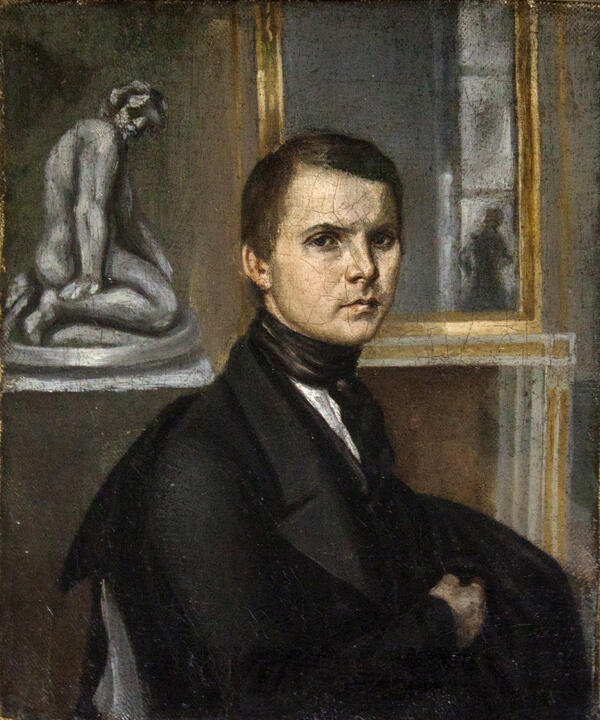In the first half of the 19th century, self-portraits were a popular genre in fine arts. Painters worked to convey their psychological states, facial expressions, posture, gaze, and entourage. The self-portrait formed the core of realistic art and communicated not only the appearance of the character, but also his position, status, and mood. There was often much more information encoded in the paintings than could be seen at first glance.
Alexander Krivoshchekov portrayed himself as a modest, focused and calm young man. He looks uptight and self-doubting, deliberately standoffish and mildly frustrated. He is neatly dressed in traditional town clothes of his time — a black frock coat, a white shirt, and a neckerchief. The painting is low-key in color scheme and follows the classical methods of composition. The self-portrait was transferred to the Komi-Permyak Local History Museum after 1930 from the archives of the Krivoshchekov family of local historians.
Alexander Kirillovich Krivoshchekov was born in 1810 in the village of Zabgan in Perm Governorate. He was a serf on the family estate of Count Stroganov. Alexander took an early interest in drawing and learned the artistic handicraft at a local workshop. As one of the best pupils, Krivoshchekov was sent to St. Petersburg to the Imperial Academy of Arts, where he was trained for four years by the professor of painting Alexander Grigoryevich Varnek. On his return home Alexander Krivoshchekov painted icons and decorated churches in Bilimbay, Pavlovsk, Chusovoye and other settlements in the Kama region. After 1848 his fate is unknown. He might have been assigned to another job, or he might have been let go “to work for hire” (that was the expression used for those who were let go to work in order to pay tribute to the landowner).
Alexander Krivoshchekov’s works were on display at the exhibition “Serf and Forgotten Painters of the Kama Region of the Late 18th — the First Half of the 19th Century” in Perm Art Gallery and in Moscow. They were included in the catalog of the series “Treasures of the Museums of the USSR”, published in Moscow in 1990 by the Union of Artists of the USSR and the Perm Art Gallery. The Komi-Permyak Local History Museum named after Pyotr Subbotin houses four artworks painted by the artist— self-portraits and portraits of relatives — as well as his private correspondence with the family.
Alexander Krivoshchekov portrayed himself as a modest, focused and calm young man. He looks uptight and self-doubting, deliberately standoffish and mildly frustrated. He is neatly dressed in traditional town clothes of his time — a black frock coat, a white shirt, and a neckerchief. The painting is low-key in color scheme and follows the classical methods of composition. The self-portrait was transferred to the Komi-Permyak Local History Museum after 1930 from the archives of the Krivoshchekov family of local historians.
Alexander Kirillovich Krivoshchekov was born in 1810 in the village of Zabgan in Perm Governorate. He was a serf on the family estate of Count Stroganov. Alexander took an early interest in drawing and learned the artistic handicraft at a local workshop. As one of the best pupils, Krivoshchekov was sent to St. Petersburg to the Imperial Academy of Arts, where he was trained for four years by the professor of painting Alexander Grigoryevich Varnek. On his return home Alexander Krivoshchekov painted icons and decorated churches in Bilimbay, Pavlovsk, Chusovoye and other settlements in the Kama region. After 1848 his fate is unknown. He might have been assigned to another job, or he might have been let go “to work for hire” (that was the expression used for those who were let go to work in order to pay tribute to the landowner).
Alexander Krivoshchekov’s works were on display at the exhibition “Serf and Forgotten Painters of the Kama Region of the Late 18th — the First Half of the 19th Century” in Perm Art Gallery and in Moscow. They were included in the catalog of the series “Treasures of the Museums of the USSR”, published in Moscow in 1990 by the Union of Artists of the USSR and the Perm Art Gallery. The Komi-Permyak Local History Museum named after Pyotr Subbotin houses four artworks painted by the artist— self-portraits and portraits of relatives — as well as his private correspondence with the family.



